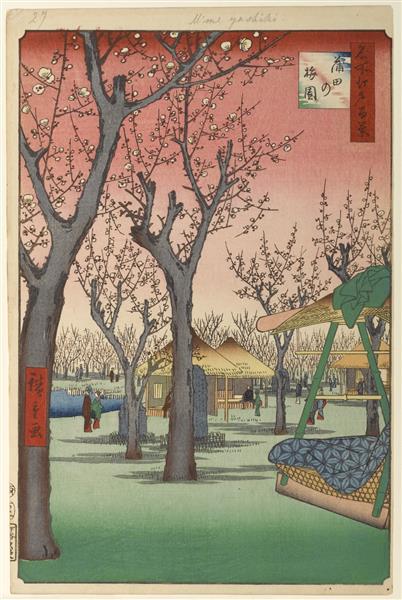Description
Utagawa Hiroshige's work, "Plum Orchard in Kamada" (1857), represents one of the most delicate and evocative manifestations of ukiyo-e, a genre that flourished in Japan during the Edo period. In this painting, Hiroshige captures the ephemeral beauty of a plum orchard in full bloom, a recurring theme in his work that symbolizes the transience of life and nature itself.
In his composition, Hiroshige employs a perspective that invites the viewer to enter into the landscape. The visual structure is orchestrated around the delicate plum blossoms, which occupy a central and dominant position, but are skillfully balanced by the depiction of a mountainous landscape in the background. The blossoming trees are presented in a rich palette of pinks, whites and greens, creating a vibrant contrast with the natural surroundings that unfold in full at the top of the work. Light filters through the branches of the blossoming trees, creating an almost ethereal effect and a sense of calm and serenity.
A distinctive element of this painting is the subtle inclusion of characters, in this case two figures who appear to be strolling beneath the shade of plum trees. Although their size and colouring are deliberately more subdued, their presence adds a human component to the landscape, suggesting an intimate connection between man and nature. This interaction is emblematic of Hiroshige’s approach to portraying everyday scenes, where human beings appear harmoniously within the context of their surroundings. The way they are depicted, almost like shadows, reinforces the idea that it must be the flowers, which symbolise both beauty and transience, that really capture the attention.
Known for his extraordinary skill in capturing light and atmosphere, Hiroshige uses subtle gradations of color and a mastery of woodblock printmaking to create textures that evoke the softness of petals and the fresh greenery of spring. This ingenious use of coloration and form allows the work to resonate with the viewer, evoking memories of natural beauty and changing seasons.
In the context of the Edo period, "Plum Orchard in Kamada" fits into the tradition of aesthetic appreciation of nature that was common among artists of the time. Hiroshige is often compared to his contemporary Katsushika Hokusai, although their styles differ significantly; while Hokusai is known for his dynamism and drama, Hiroshige tends towards a slower and more contemplative depiction of nature.
In conclusion, this work is not only a testament to Hiroshige's technical virtuosity, but also to his ability to tell stories through nature. "Plum Orchard in Kamada" transcends mere aesthetic representation by capturing a moment of serene beauty that invites reflection and appreciation of the natural world. The painting thus becomes an evocative reminder of the ephemeral, challenging the viewer to find beauty in the transient. In this work, Hiroshige, through his mastery of ukiyo-e, manages to elevate the simplicity of a plum orchard into a sublime celebration of life and nature.
KUADROS ©, a famous painting on your wall.
Hand-made oil painting reproductions, with the quality of professional artists and the distinctive seal of KUADROS ©.
Painting reproduction service with satisfaction guarantee. If you are not completely satisfied with the replica of your painting, we will refund 100% of your money.

